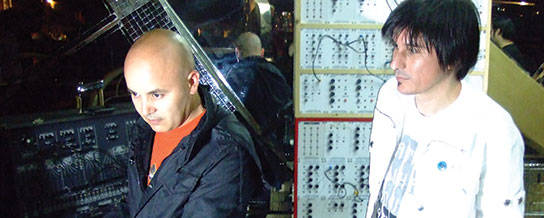Artist Tips: Bostich & Fussible
As members of Tijuana’s Nortec Collective, Bostich (Ramón Amezcua) and Fussible (Pepe Mogt) gave Mexico’s […]

Artist Tips: Bostich & Fussible
As members of Tijuana’s Nortec Collective, Bostich (Ramón Amezcua) and Fussible (Pepe Mogt) gave Mexico’s […]

As members of Tijuana’s Nortec Collective, Bostich (Ramón Amezcua) and Fussible (Pepe Mogt) gave Mexico’s traditional accordion- and horn-heavy Norteño sound some mass appeal by fusing it with electronic beats. With their recent collaboration, Tijuana Sound Machine (Naçional), the production tag team goes for a more organic sound, putting extra emphasis on acoustics. There may be obvious hints of house, techno, and D&B peppered throughout, but it’s the use of live instruments that gives TSM its futuristic mariachi swing. Here, Fussible breaks down how they gave traditional instruments the Pro Tools treatment.
Tuba
Some of the tuba sequences on Tijuana Sound Machine were sampled from previously recorded albums. We cut them up in Ableton Live and completely changed the melody and rhythm. We recorded other tuba lines with a Rode mic to then be processed through the SSL Channel Strip compressor. On songs like “Norteña del Sur” and “Rosarito” we used the Walfdorf D-Pole filter plug-in to give a more deep, rough sound.
Bajo Sexto Guitar
For this instrument, we usually recorded chords first with a synthesizer or piano. Then the guest musicians interpreted those chords with the bajo sexto(it looks like a 12-string guitar but the sound is much deeper). We then passed the music through various effects like the Sherman Filterbank, Electro-Harmonix Memory Man delay, and the Frostwave Sonic Alienator, giving it a rough, space-alien sound. In some songs, the bajo sexto was transposed 12 semitones lower to give it a sound similar to a bass.
Accordion
We always record the accordion directly to Pro Tools, using the Waves Reverb and OhmForce OhmBoyz delay plug-in. On some tracks, there were microseconds of accordion that were processed with Ableton Live’s Beat Repeater. Sometimes the accordion didn’t have the tone that we needed, so we had to transpose the accordion’s sound. On “Jacinto,” we transposed the accordion an octave or more to give it a more atmospheric sound.
Clarinet
The clarinet has a very delicate sound, so we were very subtle with its use on songs like “Wanted” and “Brown Bike.” Sometimes it’s not even recognizable even though it was recorded very clean. We used a lot of Memory Man delay on it, ending up most times with an ambient sound with significant EQ changes through the SSL Channel Strip.
Drums
When it came to the percussion, we first recorded various sessions on the Roland TR-909 Rhythm Composer, then showed them to a live drummer so that he could interpret them. The bass drum–which is played by hand and brought through an integrated ride (like the ones that marching bands use, but much larger)–and the snare and cymbals were recorded to Pro Tools and later processed through various external effects like the Sherman Filterbank, Soundcraft Folio SX EQ, and the Sonalksis KB3 plug-in. Many rhythms were processed with distortion filters. Those acoustic rhythms were eventually mixed with the TR-909, TR-808, Linn Drum, and the Sequential Circuits DrumTraks.
MP3: “Brown Bike”

